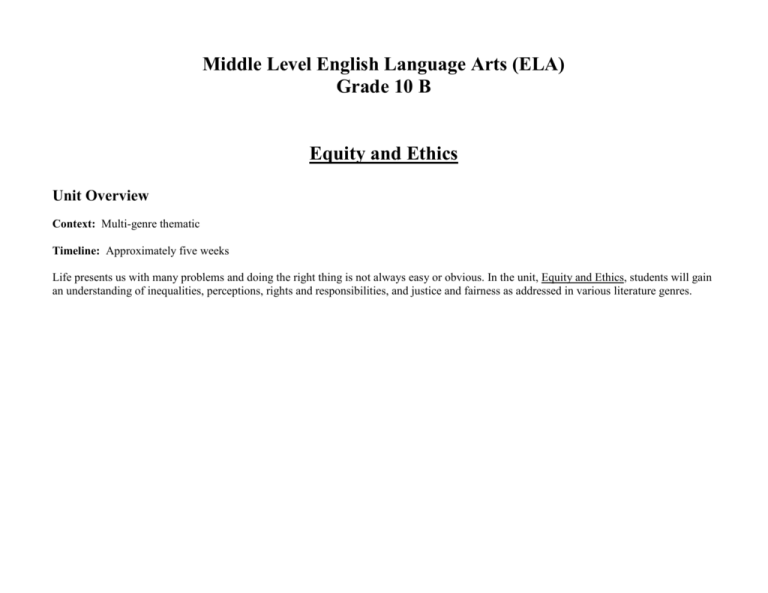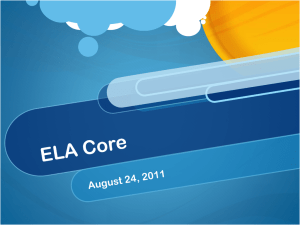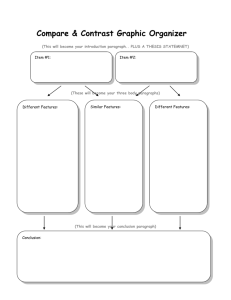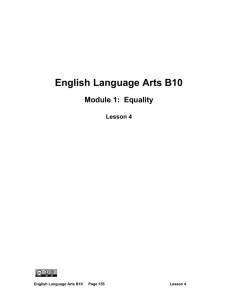1 - GSCS
advertisement

Middle Level English Language Arts (ELA) Grade 10 B Equity and Ethics Unit Overview Context: Multi-genre thematic Timeline: Approximately five weeks Life presents us with many problems and doing the right thing is not always easy or obvious. In the unit, Equity and Ethics, students will gain an understanding of inequalities, perceptions, rights and responsibilities, and justice and fairness as addressed in various literature genres. English Language Arts Goals and Outcomes Overview Comprehend and Respond (CR) CR B10.1 Comprehend and respond to a variety of visual, oral, print, and multimedia texts that address: o identity (e.g., Diversity of Being); o social responsibility (e.g., Degrees of Responsibility); and o social action (agency) (e.g., Justice and Fairness). CR B10.2 View, interpret, and report on ideas and information from more than one source to develop and support positions on various topics related to the course including identity, social responsibility, and personal agency. CR B10.3 Listen to, comprehend, interpret, and summarize information and ideas presented in a variety of literary and informational texts including group discussion, oral readings, interviews, prepared talks, and a talk-back show about a topic or issue being studied. CR B10.4 Read, interpret, and summarize a wide variety of classical and contemporary literary (including drama, biography, autobiography, poetry, short stories, novels) and informational (including letters, diaries, memoranda, electronic communications) texts. Compose and Create (CC) CC B10.1 Compose and create a range of visual, multimedia, oral, and written texts to explore: o identity (e.g., Diversity of Being); o social responsibility (e.g., Degrees of Responsibility); and o social action (agency) (e.g., Justice and Fairness). CC B10.2 Create and present a visual or multimedia presentation supporting a prepared talk on a researched issue, using either digital or other presentation tools. CC B10.3 Use oral language to express a range of information and ideas in formal (including a prepared talk on a researched issue, an interview, an oral reading of prose or poetry, and an explanation and defence of a personal point of view) and informal (including discussion and group work) situations. CC B10.4 Create a variety of written informational (including a business letter, biographical profile, problem-solution essay) and literary (including fictionalized journal entries and a short script) communications. Assess and Reflect (AR) AR B10.1 Establish and apply criteria to evaluate own and others’ work. AR B10.2 Set personal language learning goals and select strategies to enhance growth in language learning. Resources Used in This Unit Unit Organizer – Teacher Copy Reading Response Journal Information Sheets Indian Children Speak, Juanita Bell – Poem Waiting for the Welfare Check, Jacqueline Oker – Poem Imagine, John Lennon – Song Lyrics Jamie, Elizabeth Brewster – Poem Tuesdays with Morrie – Extended Fiction The Only Wheelchair in Town – Autobiography Excerpt A Good Time Tonight, Gary and Louise Hodge – Short Fiction Doing Something – Short Fiction After You My Dear Alphonse, Shirley Jackson – Short Fiction Harrison Bergeron – Short Story Incident, Countee Cullen – Poem Civilization Drilled In - Article Purpose / Outcomes Strategies and Assessment Introduction to unit Intro unit Construct meaning CR B10.1 Learning Activities Unit Organizer Introduce Unit Organizer to students. >> Unit Organizer << Introduce students to Response Journaling. Students will be responsible to add a journal entry for each piece of literature covered in class. Reader Response Handout 1 Reader Response Handout 2 --- Guiding question Hand out the extended focus question sheets. Have students work in groups of four to come up with a definition for each of the five key concept words. Discuss these as a whole group. Then give students time to individually record an initial comment for each of the questions. >> Focus Question Sheets<< --- What is Right Placemat Present several current news articles. Have students, in groups, determine what is right/wrong in each article. Use a placemat or some other cognitive strategy to involve all members of the group. TPCASTT Indian Children Speak – Poem From Literature and Language. Evanston: McDougal Littell Inc., 1994 First impression – what images stand out? What do people say about Indian children? Why does the author use examples instead of arguments? What do the children’s remarks reveal about them? Was it appropriate for aboriginal children to be sent to residential schools? Why/why not? Complete a TPCASTT analysis Journal Entry TPCASTT Journal Entry Response Journal entry Waiting for the Welfare Check – Poem Original source unknown What figurative language is used in this poem? What is the mood of the poem? How would you sentence the woman if you were the judge? Explain. Is it fair that many aboriginal people did not get a fair start in our society? Complete a TPCASTT analysis Response Journal entry Note Key Info CR B10.1 Unit Organizer Revisit Unit Organizer. Add jot notes to the first section on Expanded Unit Map. Allow students time to add additional thoughts to the Focus Questions sheet. --- --- Empowerment TPCASTT Journal Entry Song Lyric/Poem: Imagine, John Lennon Focus on the imagery in the lyrics. What messages are in the various lines and stanzas? Complete a TPCASTT analysis Response Journal entry TPCASTT Journal Entry Poem: Jamie Focus on the Point of View? How does this affect the reader’s experience? How are Jamie’s relationships with people affected? Complete a TPCASTT analysis Response Journal entry Diary Assignment Tuesdays With Morrie – Extended Fiction * Through his illness he empowered people to change. Novel Study Activities – consider Anticipation Guide, Inferences Novel Study Assignment: Personal Journal/Diary Have students create an entry for each chapter of the book Each entry to be on a separate page, dated, and accompanied by an Journal Entry illustration. Assessment Rubric The Only Wheelchair in Town – Autobiography excerpt Rick Hansen & Jim Taylor, Sightlines 10: Toronto, Prentice Hall, 2000 How does this excerpt ‘fit’ with Tuesdays With Morrie? Response Journal entry Note Key Info CR B10.1 Unit Organizer Revisit Unit Organizer. Add jot notes to the first section on Expanded Unit Map. Allow students time to add additional thoughts to the Focus Questions sheet. --- --- Rights and Responsibilities This section of the unit will focus on analyzing short stories. If necessary, review character sketch and short story analysis prior to beginning the student assignment. Short Story Lesson Handouts 10 points of a Short Story Assessing a Short Story Cooperative Group Assignment Oral Presentation Journal Entry Note Key Info CR B10.1 Unit Organizer Introduce the students to the short story study assignment. Students will complete the study in groups of 4 and present their assignment to the class. Short story selections: Short Story: Doing Something Short Story: A Good Time Tonight Short Story: After You My Dear Alphonse Short Story: Harrison Bergeron Response Journal entries for each short story Revisit Unit Organizer. Add jot notes to the first section on Expanded Unit Map. Allow students time to add additional thoughts to the Focus Questions sheet. --- --- Justice and Fairness The Incident – poem A simple incident can have a lasting impression. Journal Entry Residential Schools in Canada Horizon Canada Article Residential School article o Civilization Drilled In (page 1814) Response Journal entry Journal Entry CBC News article – A history of Residential schools in Canada http://www.cbc.ca/news/canada/story/2008/05/16/f-faqs-residentialschools.html Alternate link Response Journal entry Journal Entry CBC Canada http://www.cbc.ca/archives/categories/society/education/a-lost-heritagecanadas-residential-schools/topic---a-lost-heritage-canadas-residential-schools.html 20 audio and video clips on topic Have students explore the positive and negative experiences of residential school students. Response Journal entries for 4 of the media articles --- --- --- Note Key Info CR B10.1 Unit Organizer Revisit Unit Organizer. Add jot notes to last section on Expanded Unit Map. Allow students time to add additional thoughts to the Focus Questions sheet. Unit Assessment







